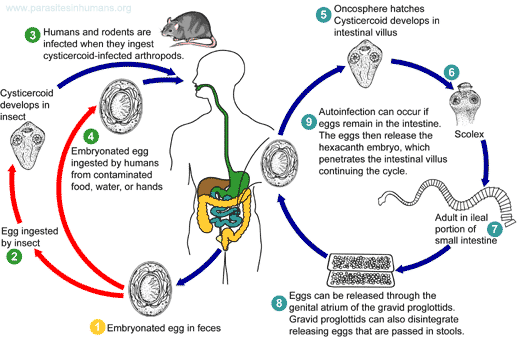Parasites In Humans
Find The Nastiest Parasites In Humans
Hymenolepis Nana - Dwarf TapewormHymenolepis nana is the most common tapeworm in humans. It is also known as the dwarf tapeworm due to its particularly small size (adults are only 15–40 mm long). The disease, hymenolepiasis is found worldwide. In temperate zones children and institutionalized people are infected more often. The disease is somewhat common in the eastern Europe. The life cycle of Hymenolepis nana starts, when microscopic eggs are passed with the stool of an infected human. They then get ingested either by rodents, humans (definite hosts) or insects (intermediate hosts). If a person ingests eggs (from contaminated fingers, water, food or soil), oncospheres (hexacanth larvae) hatch in the small intestine. A larva penetrates an intestinal villus and develops into a cysticercoid. A cysticercoid develops to look more like an adult having a scolex (head) and a neck. It bursts out of the villus, attaches to the intestinal mucosa and matures into an adult in the last part of the small intestine, ileum. Its long neck starts producing segments, proglottids, which make up the body. A proglottid absorbs nutrients from the surroundings and grows bigger before it detaches from the tail. Each proglottid has both male and female reproductive organs. It copulates with itself or with other proglottids of the same individual or nearby tapeworms. A gravid proglottid releases thousands of eggs through its genital atrium or when its membrane disintegrates. Eggs are immediately infective when passed with the stool and cannot survive more than 10 days in the external environment. If the eggs are ingested by an insect (a beetle or a flea), the larvae develop inside the insect. If the insect is ingested by a rodent or accidentally by a human, the cysticercoid larvae get inside the intestine and develop into adults. Infected rodents can contaminate water and food with their feces. According to one study, 30 % of rodents sold in pet stores in Connecticut are infected with Hymenolepis nana.
Some proglottids release eggs or disintegrate themselves already in the small intestine. Larval oncospheres (hexacanth embryo) might hatch prematurely and penetrate villi without leaving the body resulting in autoinfection. Hymenolepis nana does not necessarily need an intermediate host to complete its life cycle. Larvae can develop in spite of the high temperature of a human body. Adults live 4–6 weeks, but internal autoinfection allows hymenolepiasis to persist for years. Hymenolepiasis is usually asymptomatic in adults. But prolonged infection or multiple tapeworms especially in children can cause more severe symptoms. The worms eat your food and cause inflammation of the intestinal mucosa. The inflamed tissue will have a reduced ability to absorb nutrients. People with little food to begin with and those who are weakened by other diseases suffer the most. Hymenolepiasis symptoms sometimes include:
Your health care provider makes the diagnosis by identifying tapeworm eggs in stool. Sometimes many stool specimens are needed to make the diagnosis. Hymenolepis nana starts laying eggs within a few weeks of the start of the infection and only after that it is possible to find eggs. Alternatively adult worm can be identified during endoscopic examination. Hymenolepiasis is usually treated with a prescription drug called praziquantel which causes the tapeworm (both adults and larvae) to dissolve. A single dose of praziquantel has an efficacy of 96 %. If praziquantel is not available, niclosamide or albendazole can be used instead. To prevent getting infected:
Also check out the pictures and videos.
|
Parasites In Humans Pictures And Videos Contact Info Privacy Policy Sitemap
© 2010–2015 parasitesinhumans.org

 Wash, peel or cook all fruits and vegetables.
Wash, peel or cook all fruits and vegetables. H. nana egg is colourless, almost
transparent, oval, 30–50 µm (micrometers) in diameter, has polar filaments. When shed in stool they are
immediately infective and survive up to 10 days in the external environment, they are embryonated and have a
6-hooked oncospheres inside the shells. Shell consists of two distinct membranes. On inner membrane there are
two small "knobs" or poles from which 4–8 filaments arise and spread out between the two membranes.
H. nana egg is colourless, almost
transparent, oval, 30–50 µm (micrometers) in diameter, has polar filaments. When shed in stool they are
immediately infective and survive up to 10 days in the external environment, they are embryonated and have a
6-hooked oncospheres inside the shells. Shell consists of two distinct membranes. On inner membrane there are
two small "knobs" or poles from which 4–8 filaments arise and spread out between the two membranes.
 Scolex is small, 0.3 mm in diameter, globular
(rounded), cup-like, situated at the anterior end, has four suckers and retractile rostellum with a single row
of 20–30 hooks.
Scolex is small, 0.3 mm in diameter, globular
(rounded), cup-like, situated at the anterior end, has four suckers and retractile rostellum with a single row
of 20–30 hooks. Gravid (mature, full of eggs) proglottids are
0.2–0.3 mm long and 0.8–0.9 mm wide. Proglottid is filled with eggs, uterus is not visible. Each proglottid
has both male and female reproductive organs making Hymenolepis nana hermaphroditic. A proglottid
copulates with itself or with other segments of the same individual or nearby Hymenolepis nana
tapeworms. Proglottids usually disintegrate in the gastrointestinal tract and are rarely present in the
feces.
Gravid (mature, full of eggs) proglottids are
0.2–0.3 mm long and 0.8–0.9 mm wide. Proglottid is filled with eggs, uterus is not visible. Each proglottid
has both male and female reproductive organs making Hymenolepis nana hermaphroditic. A proglottid
copulates with itself or with other segments of the same individual or nearby Hymenolepis nana
tapeworms. Proglottids usually disintegrate in the gastrointestinal tract and are rarely present in the
feces.